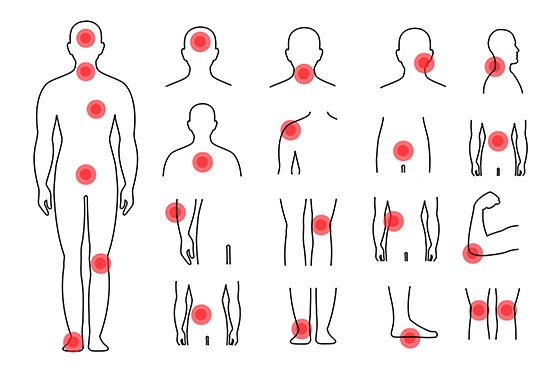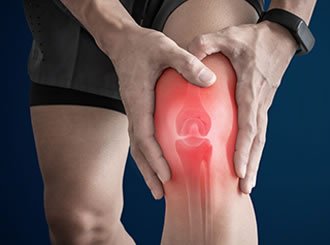
Shockwave Therapy for Myofascial Pain & Trigger Points
Shockwave therapy for myofascial pain & trigger points is a non-invasive medical treatment that uses acoustic waves to address muscle-related pain and discomfort. During the procedure, high-energy shockwaves are directed towards the affected muscles, targeting the myofascial trigger points. These shockwaves stimulate blood flow, promote tissue healing, and reduce muscle tension, leading to pain relief and improved muscle function.
Patients experiencing myofascial pain syndrome exhibit sensitive trigger points within their muscles, which can lead to referred pain in seemingly unrelated areas of the body. These trigger points are frequently attributed to repetitive motions involved in daily activities such as work, hobbies, or stress-induced tension.

What are trigger points?
Trigger points, also referred to as myofascial pain, are minute, firm knots that form within muscles, often accompanied by the hardening of fascia. These points can be excruciatingly painful and challenging to pinpoint since they can cause pain in distant areas of the body. For example, a trigger point in the upper trapezius muscle might lead to a headache, or a trigger point in the shin can cause pain in the big toe.
What are treatment options for myofascial pain?
Medications: Pain relievers, antidepressants, and sedatives can be used to manage myofascial pain syndrome.
Physical therapy: Stretching exercises, posture training, massage therapy, and heat application are beneficial.
Needle procedures: Injecting a numbing agent or steroid into trigger points can effectively alleviate pain.
Lifestyle and home remedies: Lifestyle adjustments and self-care practices at home can aid in pain management.
What is myofascial release?
Myofascial release is a process of treating the trigger points. It is actually hands-on therapeutic technique that targets the fascia, a connective tissue enveloping muscles and organs. The therapist applies gentle and sustained pressure to release tightness and restrictions in the fascia, restoring flexibility and relieving pain. This method aims to improve mobility, correct postural imbalances, and enhance overall body function. Myofascial release is commonly used in physical therapy to address issues like muscle tension, chronic pain, and limited range of motion, providing effective relief and promoting optimal musculoskeletal health.
How does shockwave therapy facilitate myofascial release and treat trigger points?
Shockwave therapy facilitates myofascial release and treats trigger points through its unique mechanism of action. When high-energy shockwaves are directed at the affected muscles, they create a mechanical force that penetrates deep into the tissues. This mechanical force leads to microtrauma at the site of the trigger points and the surrounding myofascial tissues.
As a response to this microtrauma, the body activates its natural healing processes, including increased blood flow and the release of growth factors. These processes stimulate tissue repair, improve circulation, and promote the breakdown of adhesions and tight bands associated with trigger points and myofascial restrictions.
Through this process, shockwave therapy effectively breaks down trigger points, reduces muscle tension, and helps release myofascial restrictions, thereby alleviating pain and improving mobility. The therapy’s ability to stimulate myofascial release and promote tissue healing makes it a valuable treatment option for myofascial pain syndrome and trigger points.

“I have witnessed the remarkable effectiveness of shockwave therapy in treating myofascial pain & trigger points. Patients often come in experiencing intense pain, restricted mobility, and discomfort. However, after just a few sessions of shockwave therapy, their symptoms show significant improvement. The therapy effectively releases myofascial restrictions, alleviates trigger points, and promotes tissue healing, leading to enhanced mobility and reduced pain. Witnessing such positive transformations in my patients has solidified my belief in the immense therapeutic benefits of shockwave therapy for myofascial pain & trigger points.”
Scientific Support
Abstracts Worth Recommending
[1] Ji, H. M., Kim, H. J., & Han, S. J. (2012). Extracorporeal shock wave therapy in myofascial pain syndrome of upper trapezius. Annals of rehabilitation medicine, 36(5), 675-680.
[2] Zhang, Q., Fu, C., Huang, L., Xiong, F., Peng, L., Liang, Z., … & Wei, Q. (2020). Efficacy of extracorporeal shockwave therapy on pain and function in myofascial pain syndrome of the trapezius: a systematic review and meta-analysis. Archives of physical medicine and rehabilitation, 101(8), 1437-1446.
[3] Paoletta, M., Moretti, A., Liguori, S., Toro, G., Gimigliano, F., & Iolascon, G. (2022). Efficacy and Effectiveness of Extracorporeal Shockwave Therapy in Patients with Myofascial Pain or Fibromyalgia: A Scoping Review. Medicina, 58(8), 1014.
[4] Park, K. D., Lee, W. Y., Park, M. H., Ahn, J. K., & Park, Y. (2018). High-versus low-energy extracorporeal shock-wave therapy for myofascial pain syndrome of upper trapezius: A prospective randomized single blinded pilot study. Medicine, 97(28).
[5] Mohamed, D. A. A., Kamal, R. M., Gaber, M. M., & Aneis, Y. M. (2021). Combined effects of extracorporeal shockwave therapy and integrated neuromuscular inhibition on myofascial trigger points of upper trapezius: a randomized controlled trial. Annals of Rehabilitation Medicine, 45(4), 284-293.
[6] Eftekharsadat, B., Fasaie, N., Golalizadeh, D., Babaei-Ghazani, A., Jahanjou, F., Eslampoor, Y., & Dolatkhah, N. (2020). Comparison of efficacy of corticosteroid injection versus extracorporeal shock wave therapy on inferior trigger points in the quadratus lumborum muscle: a randomized clinical trial. BMC Musculoskeletal Disorders, 21, 1-11.
[7] Anwar, N., Li, S., Long, L., Zhou, L., Fan, M., Zhou, Y., … & Yu, L. (2022). Combined effectiveness of extracorporeal radial shockwave therapy and ultrasound-guided trigger point injection of lidocaine in upper trapezius myofascial pain syndrome. American Journal of Translational Research, 14(1), 182.
[8] Nahomi Kuroda, M., Thomaz de Aquino Nava, G., Baldini Prudencio, C., Affonso Paulo, D., Peixouto, I., Yoshi Moroshima, M., … & Rodrigues Pedroni, C. (2023). Effect of ischemic compressions versus extracorporeal shockwave therapy on myofascial trigger points: A protocol of a randomized controlled trial. PloS one, 18(3), e0283337.
The Scientific Research behind It
The Effect of Extracorporeal Shock Wave Therapy on Myofascial Pain Syndrome
https://synapse.koreamed.org/articles/1149583
The Effect of Focused Extracorporeal Shock Wave Therapy on Myofascial Pain Syndrome of Trapezius
https://www.ncbi.nlm.nih.gov/pmc/articles/PMC7035035/
Randomized Trial on Comparison of the Efficacy of Extracorporeal Shock Wave Therapy and Dry Needling in Myofascial Trigger Points
Extracorporeal Shock Wave Therapy of Gastroc-soleus Trigger Points in Patients with Plantar Fasciitis: A Randomized, Placebo-controlled Trial
https://www.ncbi.nlm.nih.gov/pmc/articles/PMC4007320/